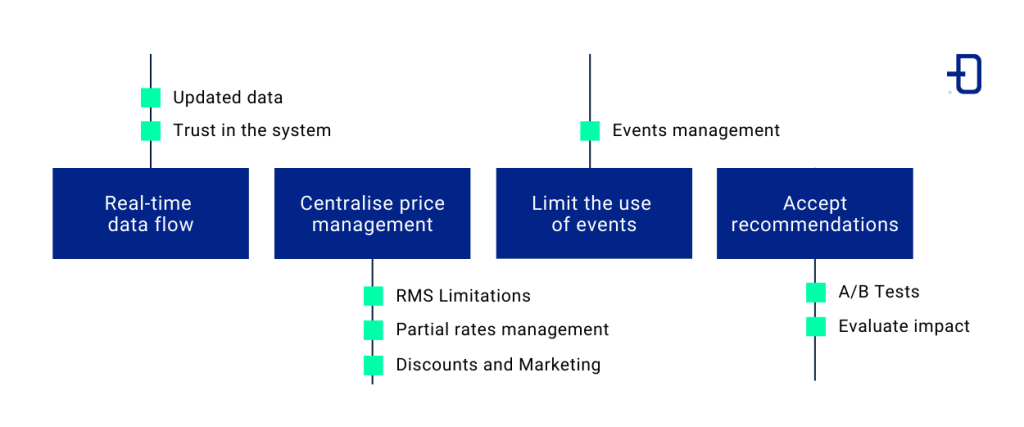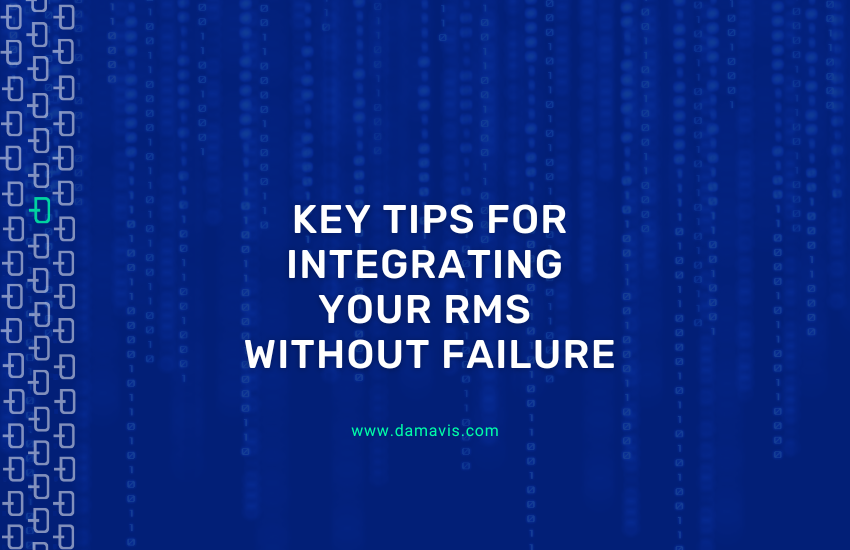The integration of technological tools and solutions based on Big Data and AI, such as Revenue Management Systems (RMS), are essential allies to maximise profits and optimise an organisation’s revenue.
More and more companies are opting for the incorporation of RMS in their operations to better manage the prices of their products. From our experience at Damavis, we have seen how their use has spread to other sectors. Early adopters were airlines and hotel chains, but now many more industries are recognising the potential of price management software.
Despite the great advantages of integration with an RMS, its effectiveness depends on how it is implemented. In this article, we will discuss four key actions to maximise the success of RMS integration.

- Real-time data flow
- Centralising price management in the RMS
- Limit the use of events
- Accept some of the pricing recommendations
- Conclusion
Real-time data flow
Both revenue managers, who are the users of the RMS, and the RMS’s own internal and automated processes, need to have the most up-to-date data possible in order to be able to make agile decisions.
It is common to find RMS integrations where data is sent only a few times a day, or even only once a day. This is where the decision making starts. On the one hand, the system’s internal forecasts make sense to update, as do the recommended prices they provide. On the other hand, revenue managers can change their pricing policy based on this new data update.
In some cases, data submission is more critical than others. Let’s take an example. Suppose a hotel has an occupancy for a future day of stay of 50%. The pricing policy in place at the RMS is in line with the fact that there is plenty of availability at the hotel at the moment. Suddenly a group booking arrives that fills 45% of the hotel. This means that if we take this group into account, the total occupancy of the hotel for that day would be 95%.
The question is, would we apply the same pricing policy with 50% occupancy and 95% occupancy? Surely not, so if that group booking takes hours to arrive at the RMS, the pricing policy in place will be out of date for that time, causing products to be sold at suboptimal prices.
Another reason for the importance of real-time data flow is to build trust in the system. It is common for revenue managers to compare the data displayed by the RMS with that of the reservation management software. If there are discrepancies, due to the fact that the reservation management software has more up-to-date data than the RMS, revenue managers will tend to:
- Being attentive to two systems to make decisions, increasing the amount of work, decreasing the speed of action and increasing the likelihood of errors.
- Stop using the RMS due to distrust in the data it manages. In this case, the investment made by the company to optimise revenues will have been in vain.
Centralising price management in the RMS
There are many scenarios in which price management is not fully realised in the RMS after integration, and the reasons for this are various. Some examples are as follows:
- Limitations of the RMS: The RMS does not support the management of all user products. For example, hotel chains need to manage prices for different types of rates, room types and regimes. Depending on the level of sophistication of the RMS, more or less of these types of products can be managed. Therefore, it is essential to conduct good market research and analyse which RMS providers are best suited to the needs of the business.
- Partial rate management: Of the multitude of tariffs that need to be managed, only a subset is managed through the RMS to simplify their use. However, this has an important trade-off: neither the revenue manager nor the RMS has a complete view of what is being sold and at what price.
- Discounts and marketing campaigns: The marketing team launches campaigns involving discounts, that is, price changes that are not managed in the RMS as they are not revenue managers. This means that the prices supposedly in force in the RMS are not really the official published prices. This has two negative impacts:
- RMS forecasting systems are affected because they do not recognise that the increase in conversions is due to a price change that the system has not observed. By retraining the predictive models, they will not be accurate due to the lack of consideration of price changes external to the RMS.
- The revenue manager loses control of the price changes that occur, hindering his decision making process. This second reason creates the need for marketing and commercial departments to work closely together.
In general, not managing all fares and products in the RMS makes it difficult for the system to make accurate predictions and optimal pricing recommendations, and makes it difficult for revenue managers to maintain control of the company’s entire pricing strategy.
Limit the use of events
It is common for RMS to have a section dedicated to event management, which the system uses to modify price predictions and recommendations. These events allow the RMS to group similar days together and use these groups in their artificial intelligence systems.
However, creating a multitude of events of low relevance can make it difficult to cluster “enough” similar days, as many days could be considered as unique contexts. This reduces the amount of historical data available to predict and make recommendations on event days.
Therefore, it is crucial that the events entered into the system are relevant enough to have a significant impact on conversion.
Accept some of the pricing recommendations
The reluctance to conduct A/B tests on pricing policy varies from industry to industry, but taking the risk of sub-optimal pricing during these tests is essential to identify the pricing policy that generates the most revenue. This risk may make it difficult for revenue managers to accept the pricing recommendations provided by the RMS.
Applying some of the RMS’s pricing recommendations allows the system to evaluate the impact of the prices it considers optimal. By allowing the system to observe the effectiveness of its recommendations, it is investing in the medium term in better suggestions, as the system will have the opportunity to learn from the impact of its proposals.
Therefore, as far as possible, it is advisable to accept some of the RMS’s price recommendations, so that the system can generate better recommendations over time.
Conclusion
In this article, we have discussed four actions that can be taken when integrating our company with an RMS to achieve the ultimate goal of these systems: to optimise the pricing policy for long-term revenue maximisation.
It is advisable that these integrations allow a real-time data flow between the systems where the data is generated and the RMS. On the other hand, it is also recommended to manage the largest number of rates and products in the RMS to make the system aware of what is being sold, how much is being sold and to allow revenue managers to have a global vision of the pricing policy.
Finally, we talked about how good event management and accepting certain recommendations from the system allow you to optimise your artificial intelligence processes.
So much for today’s post. If you found it interesting, we encourage you to visit the Software category to see similar articles and to share it in networks with your contacts. See you soon!

